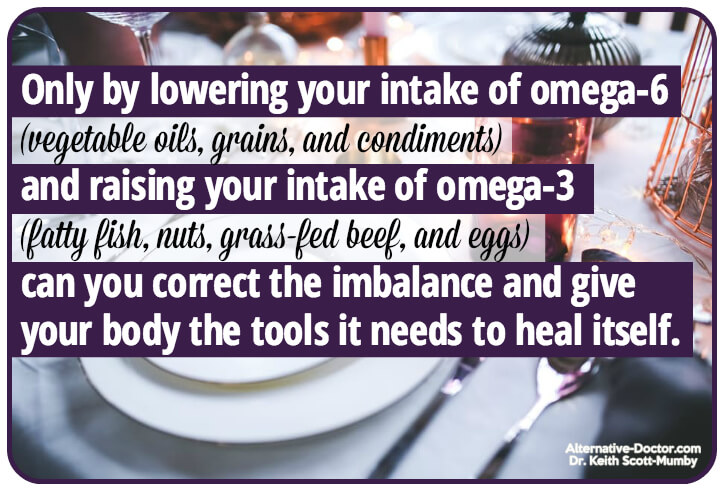For decades, “fats” have been portrayed as the villain in human health. Science has now proven (again) that some fats are not only good for you, they’re necessary to our survival. As a result, much of the “low-fat” and “no fat” craze is reversing. That’s a good thing!
However, there is a specific form of fat that’s incredibly damaging to human DNA if too much is consumed…and that’s the fat most people in the United States get more than any other. It’s been linked to an increase of diabetes risk factors in women and a host of other health problems.
I’m talking about omega-6 fatty acids.
This should not be confused with the incredibly healthy omega-3 fatty acids found in fatty fish, nuts, grass-fed beef, eggs, and leafy greens (to name a few).
Omega-3 is good for your heart and brain (and all your other parts) but the majority of American adults don’t get enough omega-3 in their diets.
Crucial Difference Between Omega-3 and Omega-6
In the U.S., average consumption of omega-6 fatty acids are ten times higher (or more) than omega-3 fatty acids.
Chances are you’re getting too many omega-6s through your daily diet through processed vegetable oils, grains, and condiments (the staple ingredients for fast food, pre-prepared meals, and snacks). Omega-6 fatty acids are important for human health (in moderation), but the Western diet has ensured that you’re already getting too many.
This is not the same scenario for omega-3s. Dangerous deficiency in this valuable nutrient is common in the populations of developed nations.
When the imbalance is so high, a side effect of omega-6 is that it blocks beneficial activity from omega-3s – such as fighting inflammation.
Your body cannot make either of these fatty acids. You must get them through food and you need them to live. Once consumed, your body transforms them into other materials to protect and heal your body but they use the same “facilities” to do it.
Omega3 and omega-6 compete for the same resources. Too much of one means the other is not being utilized properly. Maintaining the right balance is critical.

Omega-6 and Diabetes Risk Factors in Women
The research to date points overwhelmingly to greater benefits of omega-3s over omega-6s. Lowering your unhealthy fats and carbohydrate intake will help decrease your omega-6s while eating leafy greens, eggs, or seafood several times a week will raise your omega-3s.
The drawback is your sources for these fatty acids.
It’s almost unheard of for people to have omega-6 deficiency because of the garbage in our diets. Americans receive approximately 20% of their daily caloric intake from soybean oil. In a single food source (found in more foods than you can possibly imagine), the imbalance between omega-3 and omega-6 is cemented.
Scientists believe our imbalance in these fatty acids (in favor of omega-6) may explain the explosion of inflammation. An out-of-control inflammatory response is considered a root cause in most major diseases such as…
- Obesity
- Diabetes
- Cancer
- Heart disease
- Autoimmune disorders
- Mood disorders
- Chronic pain
- Dementia
- Rapid aging
However, you need to be careful about how you consume your omega-3s as well. Vitamin supplements and beef sources of omega-3 have been linked in a few studies to a higher risk of certain types of cancer and an increase in diabetes risk factors.
Food is your safest choice for nutrients but avoiding too much red meat (particularly if it isn’t grass-fed) is something to consider. Getting sufficient omega-3 fatty acids in your diet has proven beneficial in lowering your personal risk of disease.
Lower Inflammatory Foods, Lower Diabetes Risk Factors
Getting rid of fast food restaurants and pre-packaged food isn’t likely to happen in my lifetime (or yours) but if you don’t start making even gradual changes right now, your health and the health of future generations will continue to deteriorate.
Your body can’t process junk food efficiently and it can’t survive on what it offers.
Only by lowering your intake of omega-6 and raising your intake of omega-3 can you correct the imbalance and give your body the tools it needs to heal itself.
The post Certain Fats Increase Diabetes Risk Factors in Women appeared first on Alternative Doctor Dev Site.
